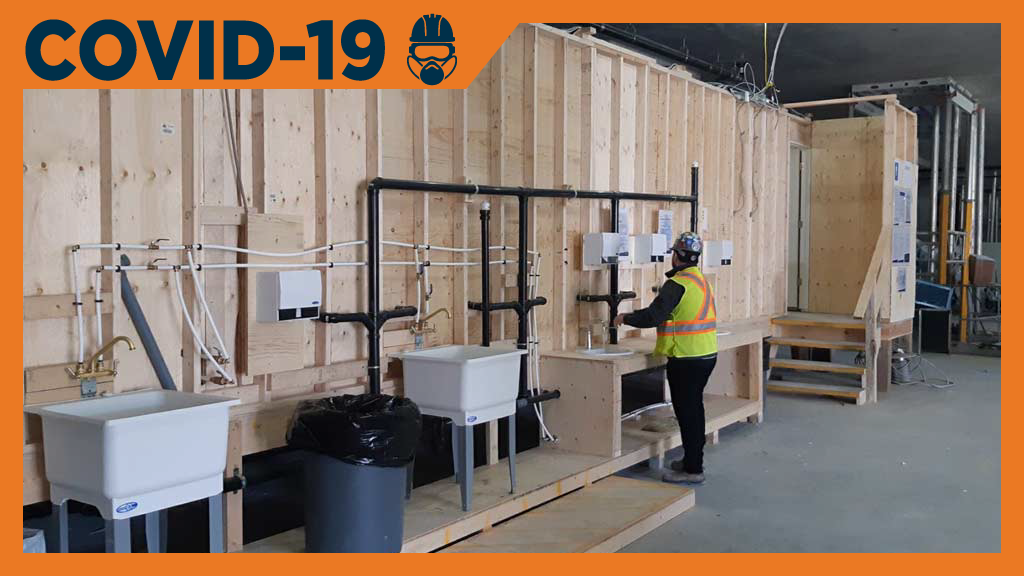As many major building sites in Toronto remain open during the era of COVID-19, construction operations have settled into new health and safety regimes to protect workers.
But some standards, such as social distancing, are difficult to meet.
“We still have tremendous problems with it on jobsites,” says Mark Lewis, general counsel of the Carpenters’ District Council of Ontario (CDCO).
Keeping workers two metres apart is especially difficult on big, busy construction sites. These days some projects are busier than before the virus struck because when the provincial government closed non-essential projects, contractors transferred workers to other projects that were deemed essential to avoid layoffs, Lewis explains.
As the general counsel representing the legal department for the CDCO, Lewis reviews site-specific problems as reported by union representatives, shop stewards and health and safety representatives on sites across the province.
Lewis has heard a lot of complaints. One concerned hoists, which are proving to be congestion points on busy sites. Under normal circumstances some hoists have a carrying capacity of up to a dozen workers, but with social distancing rules in place only two or three workers are permitted at a time.

Lewis says this can create hoist lineups with workers waiting up to 45 minutes.
“It has a huge effect on worker productivity,” he states.
It can also put the subtrades under pressure to break social distancing rules by squeezing more workers onto a hoist, he points out.
One effort by some contractors to alleviate the congestion is to stagger the start times of subtrades.
Other issues the Carpenters’ Council hears about include inadequate cleaning and disinfection standards on hoists as well as at sites in general.
At the start of the COVID-19 crisis there were “lots” of projects without running water for workers to wash, Lewis says. While many sites have improved sanitary standards recently, some still don’t take it seriously.
An example is a builder at a lowrise project who installed a water hose and a sign that says, “Bring your own soap,” Lewis describes.
Drywall taper Chris Gibbs brings his own hand soap to jobsites but recently found it missing at a residential subdivision he was working at near Caledon, Ont.
“Can you believe someone stole it,” he says.
Making sanitation matters worse at the site, the portable washroom near the house he was working in didn’t have running water and the hand sanitizer dispenser was empty.
Gibbs, a sole proprietor who does piecework for various drywall contractors, says while most of builders have maintained proper washrooms, that has not been the case at the Caledon subdivision.
He says recently bricklayer and carpenter trades walked off the jobsite over safety concerns. That has a domino effect — without framers installing walls, drywallers run out of work and tapers like Gibbs are left to look elsewhere.
The 51-year-old taper says it is too bad that it took the outbreak for sites to raise their site health standards, particularly for portable washrooms.
“The pandemic has brought a magnifying glass to it and amplified the issue for government but we have complained about these issues for years,” he says.
Lewis says the provincial government has downloaded the responsibility of site closure decisions to municipal bylaw officers or local police departments. That has resulted in different interpretations of the rules. In one instance a municipality deemed that the construction on any building permit issued prior to April 4 could continue, “which is clearly incorrect,” he adds.
Lewis says the CDCO advises workers to leave a jobsite if they think the conditions are unsafe.
He says there have been reports of “seasoned, tough construction workers” breaking down in tears on calls to the union about unsafe conditions. In some instances they report pre-existing health issues, or they have young children with illnesses or they live with elderly parents. The latter is not uncommon in some ethnic neighbourhoods of Toronto.
“Although the situation is getting better…it is questionable on a lot of sites if it is possible to do the work and meet the most basic of the guidelines put out by health officials for Canada or Ontario,” concludes Lewis.











The major issue is that contractors are more concerned with profit margin than to spend money making a clean and safe zone, we are not talking huge dollars, the skilled trades workers are there already. In the attached photos we can see plywood and 2 x 4 construction, when in blue blazes has this type of building material ever been washable and easily sanitized, it is a breeding ground for bacteria.